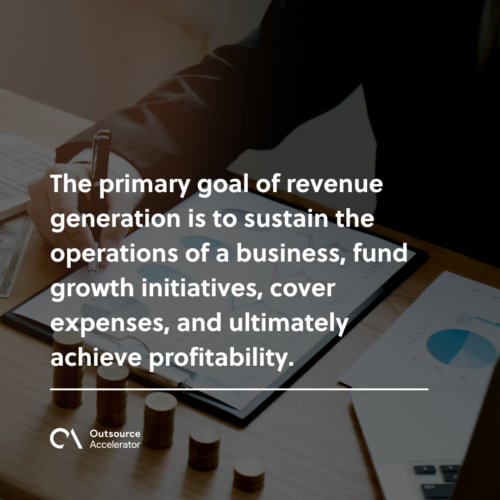Ideas to income: Maximizing revenue generation

One central pursuit unites companies across industries – revenue generation.
Whether you’re a budding entrepreneur, a seasoned business owner, or part of a dynamic corporate team, understanding the intricacies of this process is essential to achieving success.
Revenue generation isn’t a one-size-fits-all endeavor. It’s a multifaceted journey that involves a series of deliberate steps, strategies, and adaptations.
This article examines the revenue generation process to help inform businesses where they can optimize and maximize.
What is revenue generation?
Revenue generation is the process of creating and accumulating income for a business through various activities and strategies. It systematically generates funds by selling products, providing services, or leveraging other revenue streams.
The primary goal of revenue generation is to sustain the operations of a business, fund growth initiatives, cover expenses, and ultimately achieve profitability.
Revenue generation encompasses a range of activities by multiple departments. Effective revenue generation involves understanding customer needs while maintaining business sustainability.

Main components of revenue
Revenue is the total income a business generates through its primary activities, such as selling products or providing services. It’s crucial to understand the different components that contribute to revenue.
The main components of revenue include:
- Product sales – The income generated from the sale of physical goods.
- Service fees – These fees can include professional services, consulting, and maintenance.
- Subscription revenue – These are recurring payments made by subscribers.
- Licensing and royalties – You can earn revenue if your business licenses out any intellectual property you own.
- Advertising revenue – You can generate revenue through advertising placements, especially if you operate in the media, publishing, or online space.
Revenue generation process
The revenue generation process encompasses various steps and strategies that ultimately lead to the generation of income.
Let’s delve into the stages of the revenue generation process:
Market research and analysis
First, understand your target market by identifying your ideal customers and their needs, preferences, and pain points.
You must also study your competitors’ offerings and any industry trends that could impact your products.
Product or service development
Create products that address identified market needs. Focus on innovation by developing unique features, quality improvements, or convenience factors to stay competitive.
Keep in mind to design products that can be evolved over time.
Pricing strategy
Determine the perceived value of your product and set prices accordingly. Factor in production, distribution, and operation costs.
Later on, you can adjust prices based on real-time factors like demand, supply, and competitive positioning.
Sales and marketing
Tailor your marketing to reach your audience through appropriate channels. Use effective messaging to properly communicate your product’s value.
Conversion and transaction
Build trust with your customers by displaying reviews, security badges, and return policies. Make their experience as comfortable as possible by streamlining the buying process.
When you’ve built relationships with them, you can offer complementary products or additional features.
Recurring revenue models
Introduce subscription services and membership programs to secure predictable, recurring revenue. Offer exclusive perks and benefits to customers who commit to regular payments.
Customer retention and loyalty
Don’t forget to take care of your customers all the way! Provide prompt and effective support to address issues and keep them satisfied.
Data analysis and iteration
Analyze customer data, sales trends, and feedback to identify opportunities for improvement. Use this information to refine your offerings, marketing, and interactions.
Adaptation and innovation
Stay agile and adapt your strategies as market conditions and customer attitudes change. It would be best to instill an environment where new ideas and innovations are encouraged.
And, of course, technological integration is a must. Embrace tools that enhance experiences and streamline business.
Who handles revenue generation?
Revenue generation is a broad function that requires collaboration across various departments in an organization.
Here are some of the typical departments or teams that handle revenue generation activities in a business:
Sales
The sales team is responsible for generating revenue by selling products or services to customers. They interact with customers to build relationships, negotiate terms, and close deals.
Marketing
The marketing team identifies target customers, raises awareness of the company’s value proposition, and drives demand for products or services through various channels. This includes advertising, content marketing, and social media.
Customer success
The customer success team ensures customer satisfaction and retention through ongoing engagement, support, and value-added services. Keeping customers satisfied and loyal can contribute to long-term revenue generation.

Business development
The business development team focuses on generating new revenue streams. The team is responsible for identifying new markets, partners, and opportunities to expand the company’s offerings.
Finance
The finance team plays a critical role in the organization. Experts in the team set pricing strategies, analyze revenue and profitability, and manage expenses to optimize financial performance.
Product
The product team is responsible for creating and maintaining products or services that meet customer needs and drive revenue for the company.
Overall, revenue generation is a cross-functional effort requiring collaboration and alignment across multiple business departments.
Each department contributes to revenue generation in its own way, but all are working towards the shared goal of driving top-line growth and profitability for the company.








 Independent
Independent




